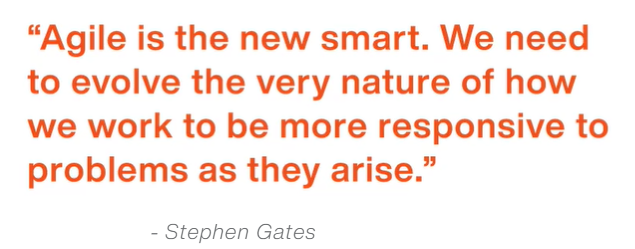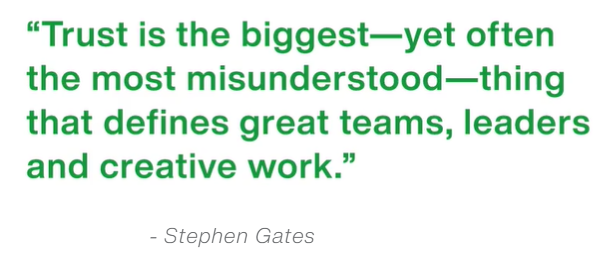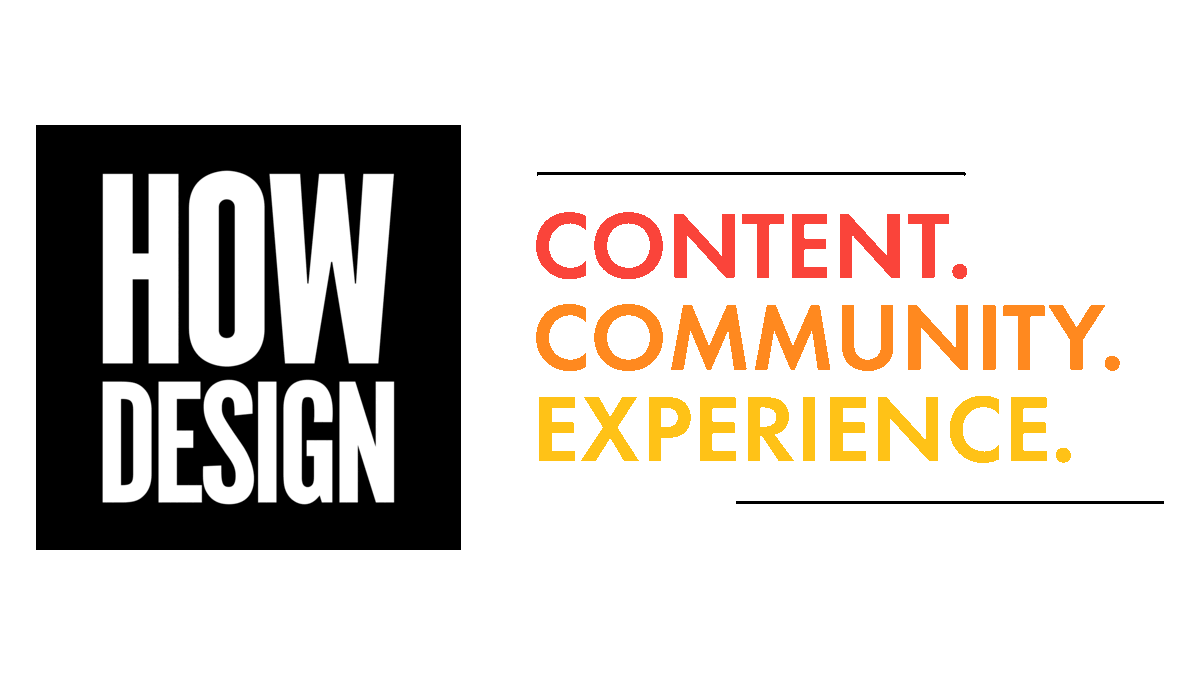
Our creative community needs leadership now more than ever.
Our quest for real leadership started long before this pandemic, but COVID-19 has created some new problems. It has mainly and painfully exposed your company’s sins and failing leadership models that have been lurking under the surface for a long time—such as when leaders are really just managers who care more about deadlines than people; when leaders lack trust, which used to short circuit creativity but now has your calendar filled with meetings as they try to figure out if you’re really working or not; and so much more. Leadership should come from anywhere, not just from the people who sit atop an org chart. But so many of us have felt powerless or unsure of where to start on the path. Let’s look at how we can break down some of the barriers that may be keeping you from having an impact and stepping up to make a difference.
REVERSAL OF THE INTIMIDATED
To understand the root of the problem, we need to go back in time to company cultures where everyone was too intimidated to talk to their boss or the corporate executives. This mindset came out of the industrialized processes that prioritized an assembly line–style hierarchy in which the chain of command was everything. As the world evolved, this mindset did as well, but it only got more entrenched into new leaders. They found ways of creating executive floors, private elevators, executive entrances and cafeterias that insulated them and protected the hierarchy by keeping them away from the rest of the company. This cycle has continued, but like any antiquated system, it has started to break down as technology and other factors give us new possibilities in how we work and build our careers. Employees feeling like they’re not valued by their companies—a problem that has long simmered under the surface—has emerged as a crisis of trust. You can see it in trends like the gig economy, where people are rejecting full-time positions in favor of independent contractor and freelancer positions so they can take control of their careers. They want to do this because they no longer trust that these companies and their leaders have their best interests in mind.  For those who remain in corporate life, we have also started to react to this crisis of trust by pushing our companies to create new ways of working, to be more collaborative and more creative. But we’ve found that all that corporate structure and those old ways of leading are short-circuiting the progress we want to create.
For those who remain in corporate life, we have also started to react to this crisis of trust by pushing our companies to create new ways of working, to be more collaborative and more creative. But we’ve found that all that corporate structure and those old ways of leading are short-circuiting the progress we want to create.
We have started to get more involved and are challenging our leadership to also work in new ways, and as a result, the intimidation that used to impact the workers has migrated to the C-suite. This is happening because employees want a new style of leadership, where hierarchy and management skills alone are not enough. They want leaders who are creative, insightful, business-savvy, inspirational, trusting and, more than anything, human. The problem is, these are not skills that have been historically prioritized at most companies as they groomed leaders, so the leaders are unsure of what to do and often react by layering on more process. This is our opportunity to step up and help everyone understand how to work in new ways. The best way for us to overcome these problems is not with more processes or new tools but rather to remind everyone how to be creative. But that’s not as simple as having more brainstorms, buying more Post-It notes or creating more prototypes. Our work has often been stifled and minced by the thinking that sits around it, so that’s what we need to start to change.
AGILE IS THE NEW SMART
Every company will use words like design, innovation or collaboration when what they really want more of is creativity. But creativity needs certain conditions to be successful in a corporate structure, and those are rarely met because of how the company approaches its work, often killing the hope of any real creativity or innovation before any work even begins. At many companies, they assemble their best people to work on a roadmap of the projects and journeys they’re going to focus on, rolling it out and then diligently spending the rest of the year following that roadmap. The problem is that time has shown us that the only thing we can count on with that approach is that shortly, that roadmap will be torn up and rethought as new priorities are added thanks to the dynamic nature of business. Instead of continuing to work like this, we need to embrace a simple idea: Agile is the new smart. I don’t mean to start using agile methodologies but rather that we need to evolve the very nature of how we work to be more agile and responsive to problems as they arise. We are used to working this way as we brainstorm an idea, prototype it, evolve it and repeat the cycle. Yet so many companies have been crippled by the COVID-19 crisis because of their inability to adopt this simple approach to deal with these sudden challenges.
Here again, this was an issue long before the pandemic, but we were able to keep it under control because of the slow pace of business, and as a result, those companies were only slowly becoming irrelevant and starting to struggle. Instead of creating endless contingency plans for how we will go back to “normal,” we must accept that rapid change is the new normal. This again is where we come in because we need to understand that one of the biggest things we need to champion is a new mindset that can make all the difference. It is a mindset that we use all the time when we are creative because there is no set answer when we start the process and we are open to the possibilities and respond to the insights we find along the way. How companies and teams respond to this new normal where agility will determine success is going to make all the difference. But that agility will also require one simple but incredibly elusive thing: trust. Stephen is currently the Head Design Evangelist at InVision where he works as a strategic partner to 100% of the world’s Fortune 100 brands to elevate the business impact of design through education, coaching and thought leadership. He previously worked at McCann Erickson, Citi and Starwood Hotels building teams that created award-winning global advertising campaigns, multiple Fortune 100 brands, and innovative digital experiences. His work has received over 150 international awards, his app design has been named as one of the World’s 100 Greatest Apps, HOW Magazine named him #17 on the 100 of the most talented and influential creatives working today, Apple has featured his work in 10 keynotes and more. He shares what he has learned through his speaking engagements and The Crazy One podcast which is an in-depth exploration of issues that matter to creatives including leadership, creativity, career development, innovation and more. 
TRUST IS THE KEY TO EVERYTHING
Trust is the biggest—yet often the most misunderstood—thing that defines great teams, leaders and creative work. Leaders need to create trust not only in personal relationships but by pushing the power traditionally only held by them down through their companies by actually trusting their employees to make decisions. I’ve talked with numerous CEOs and their leadership teams, and the first question—which so clearly illustrates the problem—has consistently been, “How do I know my people are working if I can’t see them?” I always respond, “What type of company culture have you been building where there is so little trust and empowerment, and why do you take no responsibility for that problem?” That is understandably met with a lot of blank stares and uncomfortable looks as this new reality dawns on them that the old ways of working are crumbling, and they are unsure of what to do. We need to start by understanding that there are two types of trust: practical trust and emotional trust.
Practical trust is the basic form where you trust people to do the basic things like show up on time, turn in work when it’s due, show up to meetings, etc. Emotional trust is where you trust people to do work that is good for them and the team by thinking about themselves and other people, sharing information or ideas that are not fully formed or could even be controversial. The problem is that most teams only recognize and promote practical trust behaviors, yet they expect the kind of results that you would get from teams with emotional trust behaviors.
FINDING THE LEADER IN THE MIRROR
Knowing that there are these organizational and environmental challenges gives us the foundation to understand how we can make more of an impact and step into more of a leadership role, no matter the title or seniority. There is one final significant barrier that we all also need to overcome: realizing that leadership at any level requires a different set of skills than those we usually think about. In the early parts of your career, you have to be good at producing work, which is not the same set of skills you need to be a good leader. It is a hard transition because the early stages of your career are about executional skills, like coming up with creative solutions to problems and meeting deadlines. But when you want to become a leader, you find out that requires an arsenal of skills, from understanding psychology to having the political savvy to navigate complex corporate politics, and the personal confidence to trust other people. The first problem is that many teams and companies do not help you develop any of those skills, so you have a growing sense of insecurity about how to approach any form of leadership.
The second problem is we often think we need to develop skills alone or, worse, that we should have had them all along. This is complicated by the fact that since there is no real leadership development, companies just throw people at leadership positions, assuming that past success will be an indication of future leadership. Time after time, you see that someone who was a fantastic designer suddenly struggles or fails as a new leader because they were unprepared for the challenges. In some cases, it becomes even worse because they treat leadership as an executional task, becoming a manager instead of a leader.  I’ve found that there is no perfect time or amount of experience that will make you feel comfortable stepping up to become a leader. That is even more true lately when it can be easy to let all this change, imposter syndrome and uncertainty win. But hidden in all of that is a silver lining because there has never been a time when we need leadership more, and people have been empowered to work in new ways. I’m reminded of a simple phrase that is the best advice I’ve ever gotten when it comes to leadership: “Leadership is your ability to become the most confident uncertain person.”
I’ve found that there is no perfect time or amount of experience that will make you feel comfortable stepping up to become a leader. That is even more true lately when it can be easy to let all this change, imposter syndrome and uncertainty win. But hidden in all of that is a silver lining because there has never been a time when we need leadership more, and people have been empowered to work in new ways. I’m reminded of a simple phrase that is the best advice I’ve ever gotten when it comes to leadership: “Leadership is your ability to become the most confident uncertain person.”
For creatives to get more respect, get a seat at the leadership table and create the type of impact we all know we can have, we need to step into being uncomfortable. We need to reawaken the creativity that has gone dormant in too many of the people we work with and nurture it into something that will change our companies. It will not be easy or simple, but it will be worth it, and I know you are the ones who can make it happen. I ended my keynote at HOW Design Live 2019 with these words, and they seem more relevant than ever: Exist loudly.
Stephen is currently the Head Design Evangelist at InVision where he works as a strategic partner to 100% of the world’s Fortune 100 brands to elevate the business impact of design through education, coaching and thought leadership. He previously worked at McCann Erickson, Citi and Starwood Hotels building teams that created award-winning global advertising campaigns, multiple Fortune 100 brands, and innovative digital experiences. His work has received over 150 international awards, his app design has been named as one of the World’s 100 Greatest Apps, HOW Magazine named him #17 on the 100 of the most talented and influential creatives working today, Apple has featured his work in 10 keynotes and more. He shares what he has learned through his speaking engagements and The Crazy One podcast which is an in-depth exploration of issues that matter to creatives including leadership, creativity, career development, innovation, and more.

